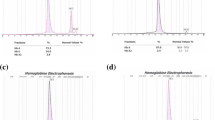Abstract
A large majority of microcytic hypochromic anemia have defects in cellular hemoglobin synthesis due to either iron deficiency or thalassemia trait; both differing in management and prognosis. HPLC and serum iron profile as confirmatory tests are unavailable at health care centers. Blanket therapy of iron supplements is therefore given in all such cases which may cause iron overload in thalassemia cases. Easy to use and cost effective screening methods are desirable. The present study was undertaken to evaluate the diagnostic accuracy of twelve indices to effectively screen cases of thalassemia trait and differentiate them from iron deficiency anemia. Routine samples from the hematology lab with Hb < 13 gm/dl, MCV < 80 fl and MCH < 27 pg were screened. Taking HPLC and serum ferritin as gold standard, out of total 1353 cases, 98 cases of thalassemia trait (HbA2 > 3.5 on HPLC) and 1102 cases of iron deficiency anemia (serum ferritin < 12 g/ml) were evaluated using discrimination indices. Diagnostic accuracy for each index was calculated. While few indices showed a sensitivity of 100%, their specificity was low which meant more number of false positive cases. Based on Youden’s Index, which measures the diagnostic tests ability to balance sensitivity and specificity, the best three indices in the decreasing order of their efficacy in our study were Ricerca Index (RI), Green and King Index (GKI) and Mentzer Index (MI). MI is considered a reliable index by many clinicians since a long time, however RI and GKI were found to have a better diagnostic accuracy based on our study.
Similar content being viewed by others
References
Madan N, Sharma S, Sood SK, Colah R, Bhatia LH (2010) Frequency of β-thalassemia trait and other hemoglobinopathies in northern and western India. Indian J Hum Genet 16(1):16–25
Sirdah M, Tarazi I, Al Najjar E, Al Haddad R (2008) Evaluation of the diagnostic reliability of different RBC indices and formulas in the differentiation of the beta-thalassaemia minor from iron deficiency in Palestinian population. Int J Lab Hematol 30(4):324–330
Bhushan R, Shukla S, Singh D, Trivedi SS, Sharma S (2018) Reliability of different RBC indices to differentiate between beta thalassemia trait and iron deficiency anemia during antenatal screening. World J Pathol 7:14–20
Kumar A, Saha D, Kini J, Murali N, Chakraborti S, Adiga D (2017) The role of discriminant functions in screening beta thalassemia trait and iron deficiency anemia among laboratory samples. J Lab Physicians 9(3):195–201
Meshram P, Kokandakar HR, Bindu RS (2017) Study of blood indices and high performance liquid chromatography (HPLC) in differentiation of β-thalassemia trait and iron deficiency anemia. Int J Res Med Sci 5(11):4728–4736
Vehapoglu A, Ozgurhan G, Demir AD, Uzuner S, Nursoy MA et al (2014) Hematological indices for differential diagnosis of beta thalassemia trait and iron deficiency anemia. Anemia. https://doi.org/10.1155/2014/576738
Chuan S, Yong-mei J, Hua S, Jin-hao L, Wen-jie Z, Qing-kai D et al (2010) Evaluation of indices in differentiation between iron deficiency anemia and β-thalassemia trait for Chinese Children. J Pediatr Hematol Oncol 32(6):e218–e222
Niazi M, Mohammad T, Raziq F, Hameed A (2010) Usefulness of red cell indices in differentiating microcytic hypochromic anemias. Gomal J Med Sci 8(2):125–129
Singh YK, Garg S, Srivastava A, Singh S, Jaiswal R (2016) Role of hematological indices in the screening of β-thalassemia minor (trait) and iron deficiency anemia. Am Res J Hematol 1(1):1–5
Rathod DA, Kaur A, Patel V, Patel K, Kabrawala R, Patel V, Patel M, Shah P (2007) Usefulness of cell counter-based parameters and formulas in detection of beta-thalassemia trait in areas of high prevalence. Am J Clin Pathol 128(4):585–589
Mukhopadhyay D, Saha K, Sengupta M, Mitra S, Datta C, Mitra PK (2015) Role of discrimination indices in screening of beta-thalassemia trait in West Bengal, India: an institutional experience on 10,407 subjects. Saudi J Health Sci 4:151–155
Demir A, Yarali N, Fisgin T, Duru F, Kara A (2002) Most reliable indices in differentiation between thalassemia trait and iron deficiency anemia. Pediatr Int 44(6):612–616
Okan V, Cigiloglu A, Cifci S, Yilmaz M, Pehlivan M (2009) Red cell indices and functions differentiating patients with the β-thalassaemia trait from those with iron deficiency anemia. J Int Med Res 37:25–30
AlFadhli SM, Al-Awadhi AM, AlKhaldi D (2007) Validity assessment of nine discriminant functions used for the differentiation between iron deficiency anemia and thalassemia minor. J Trop Pediatr 53(2):93–97
Ntaios G, Chatzinikolaou A, Saouli Z, Girtovitis F, Tsapanidou M, Kaiafa G et al (2007) Discrimination indices as screening tests for beta-thalassemic trait. Ann Hematol 86(7):487–491
Ehsani MA, Shahgholi E, Rahiminejad MS, Seighali F, Rashidi A (2009) A new index for discrimination between iron deficiency anemia and beta-thalassemia minor: results in 284 patients. Pak J Biol Sci 12:473–475
Author information
Authors and Affiliations
Corresponding author
Ethics declarations
Conflict of interest
None.
Additional information
Publisher's Note
Springer Nature remains neutral with regard to jurisdictional claims in published maps and institutional affiliations.
Rights and permissions
About this article
Cite this article
Bhargava, M., Kumar, V., Pandey, H. et al. Role of Hematological Indices as a Screening Tool of Beta Thalassemia Trait in Eastern Uttar Pradesh: An Institutional Study. Indian J Hematol Blood Transfus 36, 719–724 (2020). https://doi.org/10.1007/s12288-020-01282-z
Received:
Accepted:
Published:
Issue Date:
DOI: https://doi.org/10.1007/s12288-020-01282-z



